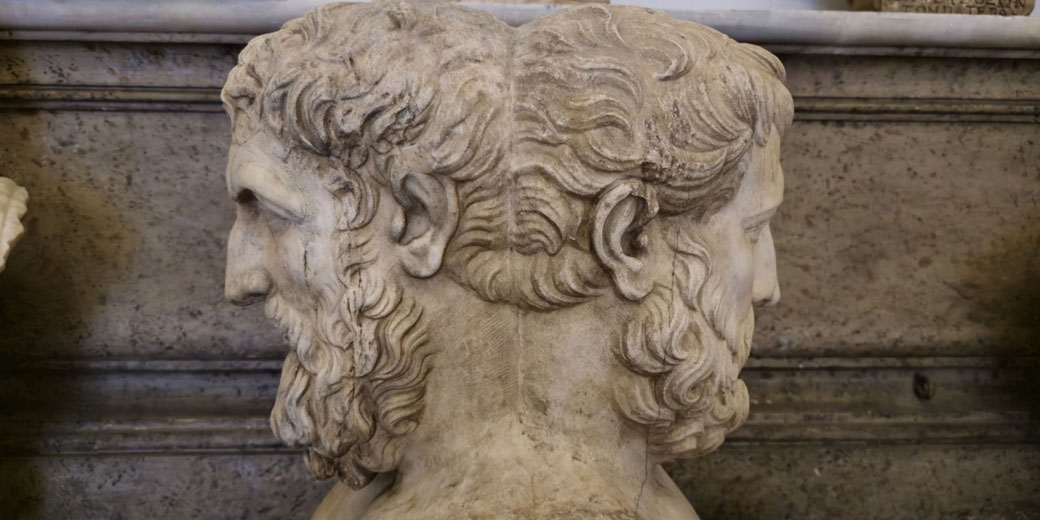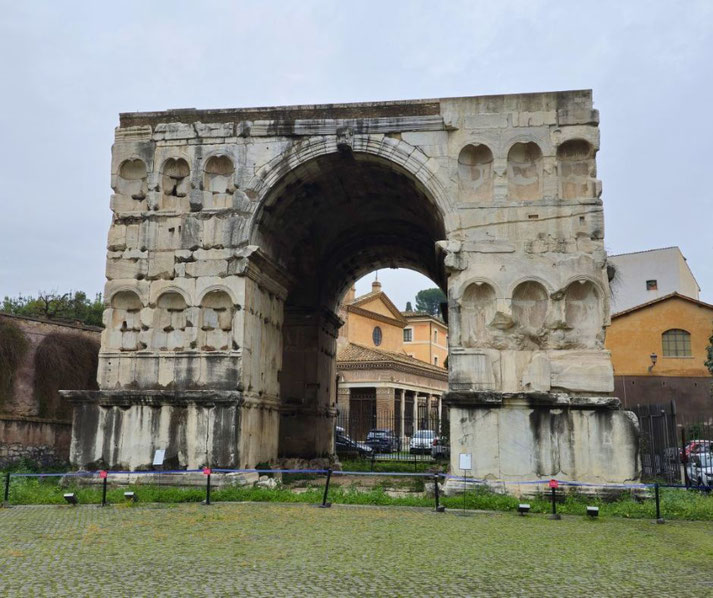Janus: Roman god of the New Year, who sees both yesterday and tomorrow

At the beginning of each Roman year, citizens commonly honoured Janus, the two-faced god who presided over transitions, gateways, and time.
With one face that looked backward and the other that looked forward, Janus represented both reflection and renewal.
His influence was common on coins, in shrines, and via prayers at the start of many public rituals.
Who was the Roman god Janus?
Romans identified Janus as a uniquely Roman deity who had origins in the oldest Italic beliefs rather than in Greek tradition and who was the guardian of doorways, boundaries, and all things that began or ended.
His name derived from the Latin word ianua, which meant "door" and showed his authority over thresholds, including those between years, months, days, and even states of being.
Because Romans associated Janus with the start of everything, they typically invoked him at the commencement of every ceremony, public or private, because even minor domestic rituals required his acknowledgement before they turned to other gods.
In his treatise De Lingua Latina, Varro described Janus as the first recipient of all prayers because he stood for the beginnings of action itself.
According to ancient authors such as Varro, Livy, and Ovid, Janus had existed before Jupiter and had ruled during a mythical golden age.
In one tradition, he had welcomed Saturn after the latter had been expelled from the heavens, and they had ruled together in peace.
As a result, Janus had earned a reputation as a civiliser and teacher, who had brought law, money, and agriculture to the people of Latium.
Cicero, in his philosophical works, referred to Janus as a symbol of beginnings and temporal order but did not explicitly deny his mythological attributes.
The god's representation in art featured two faces that were joined at the back of the head, with one that looked to the past and the other that looked to the future.
For example, this image appeared on coins, carved panels, and statues that were located near gates, archways, and bridges.
Roman bronze ass coins during the Republic often bore his double-faced image on one side and a ship's prow on the other, which indicated his connection to transitions and commerce.
The Janus Geminus was the most famous of his shrines and stood in the Roman Forum near the Argiletum, and featured two bronze doors that remained open in times of war and closed only during rare periods of peace.
According to Livy, these doors were closed only twice before Augustus: once under Numa and once in 235 BCE after the First Punic War.
Augustus later claimed that he had closed them three times during his reign.

What stories did the Romans tell about Janus?
Romans did not assign to Janus the heroic or scandalous tales that often surrounded other deities.
Instead, they told stories that explained his relationship with the early kings and the founding of Rome.
One such tale placed Janus on the Janiculum Hill, where he ruled as a wise king and instructed his people in useful arts.
During the reign of Romulus, when the Sabines attempted to storm the city, Janus reportedly unleashed a spring that released boiling water to repel the invaders.
As a result, Romans viewed him as a protective power who defended the city with divine force rather than with weapons.
They later honoured him as a guardian of both physical and symbolic frontiers.
Ovid recounted this episode in Fasti, describing Janus as a watchful force who remained vigilant over Roman boundaries.
According to the poem, he had held the keys to both the heavens and time, and he alone had been able to open the way to other gods.
For that reason, priests always named him first in religious ceremonies. Macrobius later expanded on this idea in Saturnalia, where he interpreted Janus as the cosmic origin of all motion and structure.
How was Janus worshipped?
At home, Roman families included Janus in their lararia, the small shrines that were placed near household entrances.
They viewed him as a protector of the threshold who guarded those coming and going.
Because people commonly made simple offerings of wine, incense and grain at the start of each day, these household rituals placed Janus alongside the Lares and Penates, which formed a triad of domestic protection.
In this way, Janus remained part of daily life without the need for grand temples or spectacular rites.
Two official festivals honoured him during January. On the 9th, the Agonalia involved the public sacrifice of a ram by the rex sacrificulus, a priest who performed ancient state rites.
Although the Agonalia occurred multiple times each year, the January rite specifically honoured Janus as the guardian of beginnings.
Later that month, the Carmentalia joined Janus with Carmenta, a goddess of childbirth and prophecy.
Although the festival primarily celebrated Carmenta, the temporal focus of the month encouraged Romans to associate Janus with the theme of beginnings.

God of the New Year: Why January bears his name
The decision to begin the Roman year on 1 January placed Janus at the centre of timekeeping.
When Julius Caesar introduced the Julian calendar in 45 BC, he formalised a political practice that had already existed because Roman consuls had taken office on the first of January since at least 153 BC, giving the month official significance long before Caesar's reform.
Romans viewed Ianuarius, or January, as the natural time to honour Janus. On the Kalends of January, citizens traditionally offered prayers and exchanged gifts, including coins, dates and honey, because these acts were intended to please the god and secure his favour for the year ahead.
Ovid wrote that people often greeted one another with kind words and presented sweet foods as omens of a sweet year.
For example, figs and dried fruit represented prosperity, while small copper coins represented hope for good fortune.
Today the month-name preserves the clearest trace of Janus, and people associated him with the passing of years and with new starts that continued after his temples fell and his rites ended.
What do you need help with?
Download ready-to-use digital learning resources
Copyright © History Skills 2014-2025.
Contact via email
With the exception of links to external sites, some historical sources and extracts from specific publications, all content on this website is copyrighted by History Skills. This content may not be copied, republished or redistributed without written permission from the website creator. Please use the Contact page to obtain relevant permission.





